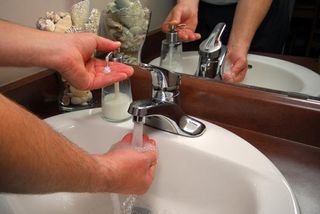Gross! Just 5 Percent of Bathroom Users Wash Hands Correctly

After using the bathroom, 95 percent of people fail to wash their hands long enough to kill harmful bacteria, a new study finds.
Researchers also found that only two in three people use soap, while one in 10 skips the sink altogether, and men get much lower marks for hand hygiene than women.
A team from Michigan State University trained a dozen students to inconspicuously observe and collect data on hand-washing behavior in restrooms in bars, restaurants and other public places in a college town. In all, 3,749 people were observed.
The U.S. Centers for Disease Control and Prevention (CDC) recommends that you wash your hands vigorously using soap and water for 15 to 20 seconds, or the time it takes to sing or hum "Happy Birthday" twice. But on average, bathroom users only washed their hands for 6 seconds, and just 5 percent washed their hands for 15 seconds or longer, the researchers found.
Among men, only half used soap and 15 percent didn't wash their hands at all, compared with 78 percent of women who used soap and 7 percent of women who didn't wash their hands.
"These findings were surprising to us because past research suggested that proper hand washing is occurring at a much higher rate," study researcher Carl Borchgrevink, a Michigan State associate professor of hospitality business, said in a statement.
The researchers additionally found that people were less likely to wash their hands when faced with a dirty sink, whereas a clean sink increased the length of time spent hand washing. People also were more likely to wash their hands earlier in the day and if there was a sign encouraging them to do so. The study suggests such signage could be particularly helpful in men's bathrooms.
Sign up for the Live Science daily newsletter now
Get the world’s most fascinating discoveries delivered straight to your inbox.
The CDC says hand washing is one of the most effective ways to cut the spread of infectious diseases. Dirty hands are estimated to contribute to 50 percent of all foodborne illness outbreaks.
The research appears in the Journal of Environmental Health.
Follow us @livescience, Facebook & Google+. Original article on LiveScience.com.
